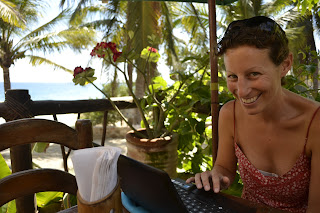A Mexican Gandalf was blocking our path as we were on our way snorkelling in the Yucutan peninsula. “You shall not pass!” he cried in Spanish (*rough translation), his hands outstretched, his eyes wild. Except this man was less powerful wizard, and more bandito on drugs, and he also happened to be our taxi driver. Our journey to the cenote had gone horribly wrong.
We’d mistakenly hired Gandalf after an incredible morning on Akumal beach, swimming with enormous turtles. It had been amazing to watch these magical creatures as they munched on sea grass like horses, before soaring gracefully to the surface for a mouthful of air. We – Dan, me, and a young Swedish couple – were buzzing as we left the beach.
Perhaps this is why we didn’t quite have our wits about us as we jumped in the car with Crazy Gandalf for the quick trip to the cenote – one of the many limestone sinkholes in the Yucatan which you can swim, dive or snorkel. We might have noticed he looked a little unhinged. Instead, we agreed a price of 150 pesos to take us down the motorway and 2.5km inland to the cenote. Except as we returned from the ticket office at the entrance, Gandalf upped the price to 200 pesos to the cenote, and 150 to where we were now. We muttered every Spanish swearword we knew.
We refused to pay unless he took us all the way. He said he’d call the police. Go ahead, we said, you lying b*stard. He made various motions with his car radio and cell phone, the locals involved were siding with him, and with daylight fading and our tickets already bought, we decided to walk in.
A long dirt road, thronged by forest on both sides, extended for kilometres into the distance. We began the long plod. After a few minutes, we realised Crazy Gandalf was coming after us. He drove alongside very slowly, looking increasingly wild-eyed, still threatening to call the police. It was beginning to feel a little like a horror film, especially when he parked his car across the road, got out, and stood with his arms folded across his chest.
Admittedly, he was very small. Dan, furious, decided he could take him out. “Hold this,” he said, flinging the bag of snorkelling gear at me. They eye-balled each other for a while, hands on each other’s chests. But when another taxi driver drove up and got out to back up his mate, I saw it all going badly wrong. Isolated road, crazy Mexicans, not worth it. We threw the money at him, congratulated him on welcoming tourists to his country with such zest, and, hearts thumping, kept walking as he finally drove away.
Anyway, this should have been a piece on cenotes, and once we all calmed down, the afternoon was an amazing one. I’d never heard of a cenote before I reached this part of the world – but there are thousands of them here. They’re caused by rocks dissolving over time, revealing pools of rainwater underneath. Some are circular, open pools (the Mayans used them for human sacrifices) – but others are flooded underground caves, with the roof still intact.
We were heading for one of the biggest cave systems on the peninsula, Dos Ojos – Two Eyes. It was only discovered in the 1980s, and has been mapped by divers at more than 80 kilometres long, with one passage reaching depths of 120 metres. (Fans of the BBC’s Planet Earth series would recognise it.) Snorkelling, we were only skimming the surface – but what an experience that was. It made me desperate to learn to dive.
We plunged into cool, perfectly clear, cobalt water, the cave stretching into the dark before us. Sunlight filtered in, illuminating rock formations below the surface. Diving down, we entered a subterranean wonderland: I swam between twisting stalactites and stalagmites, past rocks patterned like coral with circles and lines, touching stones dripping fantasy formations. It was like swimming through the set of Fraggle Rock. In parts, the cave roof was very low: you had to watch your head as you surfaced. When we stopped, small fish would surround us, nibbling at our skin. It was incredibly peaceful, and we had the place to ourselves. It made all the madness to get there worth it.
Inspired, I dragged Dan to more cenotes near Valladolid. They were smaller, and more commercial: the presence of disco lights and life jackets was a tad unnecessary, but the rock formations were amazing: great hulks of rock hung from the roof, patterned like mammoth-hair. In both, the tangled roots of a tree growing on the roof of the cave spilled down to touch the water 20 metres below. (And this time our taxi driver was a gem: we practised our Spanish with him the whole way there and back.)
If you ever get the chance, swim a cenote. It is a magical experience. Just mind how you get there.



























































